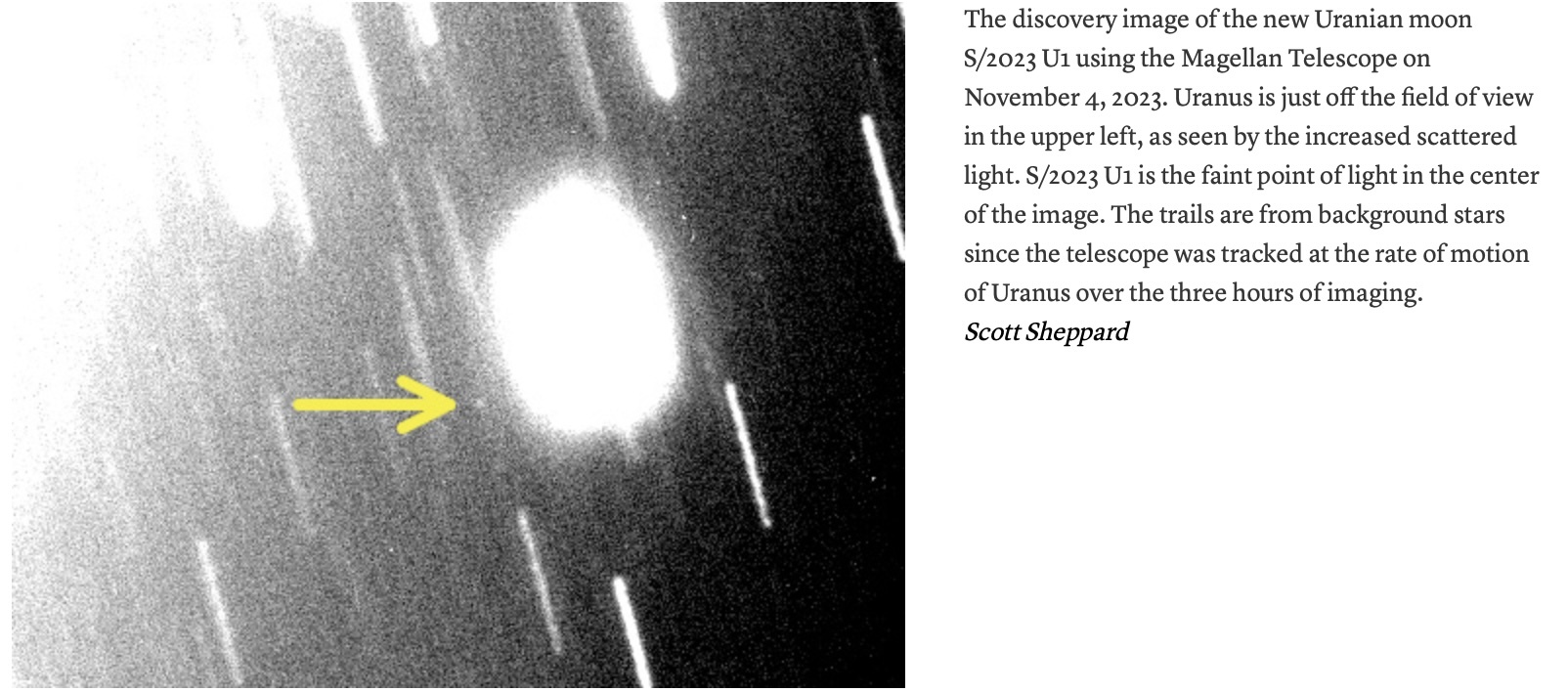2.03.2024
The three new moons for Uranus and Neptune are each part of a “family,” groupings that fragmented from a single parent object.

Uranus (left) and Neptune (right)
Patrick Irwin / University of Oxford/NASA
The discovery of three previously unknown moons of Uranus and Neptune shows that the ice giants, like Jupiter and Saturn, have families of far-flung moons formed by the fragmentation of larger, captured objects. More moons are likely out there, but we’d need to send a space probe to see them.
Dozens of moons have been discovered around Jupiter and Saturn over the past two decades. However, since 2003 no new moons had been discovered orbiting Uranus, and only one new moon was officially added for Neptune. The new discoveries bring the total tally to 28 for Uranus and 16 for Neptune.
These outer solar-system moons are hard to find, Scott Sheppard (Carnegie Science) says, because "these objects are at the edge of detectability."
Planetary scientists suspect that the outer solar system may hold the key to understanding how the solar system formed and its early evolution. Because of that, the decadal survey released last year by the National Academy of Sciences put a high priority on launching a major mission in the mid-2030s called the Uranus Orbiter and Probe. "The ice giants have been neglected," says Sheppard. He adds that some have even urged a mission to Neptune.
THREE NEW MOONS
The International Astronomical Union's Minor Planet Center announced the three new moons on February 23rd : one around Uranus and two around Neptune. They are the faintest moons yet that ground-based telescopes have found orbiting the ice giants.
The one orbiting Uranus, provisionally designated S/2023 U1, is the first new moon discovered orbiting the ice giant in more than 20 years. At only 8 kilometers (5 miles) across, it is probably the planet's smallest known moon. It has an orbit of 680 days. Sheppard first spotted S/2023 U1 on November 4, 2023, with the Magellan telescope at Las Campanas Observatory in Chile. Follow-up observations in December firmed up its orbit, which in turn helped identify previously unrecognized observations of the moon in 2021 with the Magellan and the Subaru telescopes in Hawai‘i.

The two new moons orbiting Neptune had both been spotted earlier but had not been observed long enough to calculate their orbits.
Sheppard first discovered the brighter and larger one in October 2021 with Magellan, and he collaborated on further observations in 2022 and 2023. After he worked with Marina Brozovic and Bob Jacobson (both at NASA Jet Propulsion Laboratory) to calculate its orbit, they realized it had been observed near Neptune two decades earlier. Provisionally designated S/2002 N5, it measures 23 kilometers across and takes nine years to circle Neptune.
The smaller Neptunian moon, provisionally designated S/2021 N1, is about 14 km across and takes almost 27 years to orbit Neptune — the longest orbit known for any planetary moon. Sheppard and colleagues first saw the extremely faint moon with the Subaru telescope in September 2021. To make the observations needed to calculate the faint moon's orbit, they added observations from the Very Large Telescope in Chile and the Gemini North Telescope in Hawai‘i.
Each of the three new moons has an orbit that groups it with the orbits of two larger moons. The newly found S/2023 U1 falls in a group with two larger and better-known moons of Uranus, Caliban and Stephano. At Neptune, the orbits of Psamathe and Neso are similar to that of S/2021 N1, and the orbits of Sao and Laomedeia are similar to that of S/2002 N5. These groupings are probably families, formed by the breakup of a larger, captured object.
Finding more such faint and distant moons will be tough. To find these three, Sheppard had to make a series of five-minute exposures to keep the moon's motion from blurring in individual images. Sequences of images were taken over a period of up to four hours, when the moons remained high enough in the sky for good seeing. He also needed to collect data over a series of nights, and then stack the exposures carefully to obtain images deep enough to show the moon.
This technique is powerful, but with such faint objects it requires a lot of time on the world’s biggest telescopes. The Uranus Orbiter and Probe would offer the opportunity to get up-close to objects that are just faint points in the sky to Earth’s biggest and best telescopes.
Quelle: Sky&Telescope
